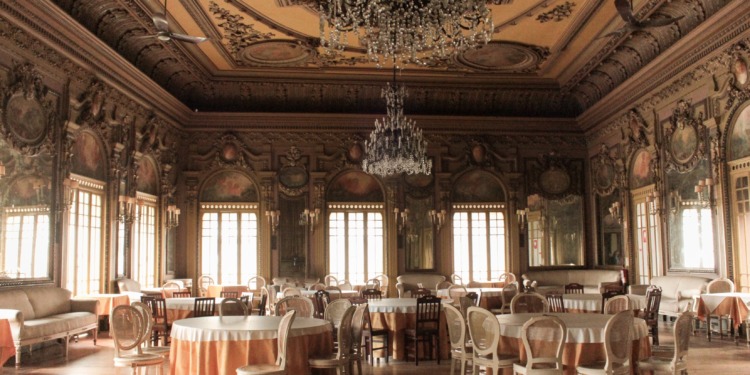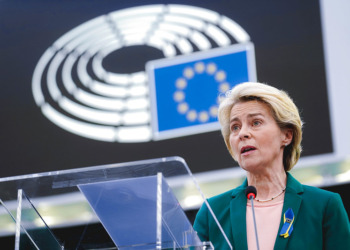In an effort to get young people excited about the EU initiative Global Gateway, which kicked off one year ago, the European Commission has invested €387k in an online virtual reality platform. A few weeks ago, the digital platform was launched to a generally critical reception. This criticism transformed into ridicule when a party hosted by the EU in its metaverse welcomed only five attendees, including one journalist
Now, people are questioning how the initiative is choosing to spend tax-payer money.
What is the Global Gateway?
The Global Gateway is an initiative from the European Commission, the EU’s politically independent executive arm, that began on Dec. 1, 2021. In the European Commission’s own words, the Global Gateway is:
“…the new European Strategy to boost smart, clean and secure links in digital, energy and transport and strengthen health, education and research systems across the world. It stands for sustainable and trusted connections that work for people and the planet, to tackle the most pressing global challenges, from climate change and protecting the environment, to improving health security and boosting competitiveness and global supply chains.”
Perhaps unsurprisingly, the initiative has already faced criticism for lack of transparency and concrete details in how it intends to accomplish these lofty ambitions. Essentially, the initiative is an investment plan to develop new infrastructures in developing countries.
The ultimate aim is to mobilise €300 billion in investments by 2027 to aid the global recovery from COVID and utilise the unique global post-COVID situation to create meaningful change in global infrastructures. However, much of this monetary total still relies on projected investments, and the EU Court of Auditors have cast doubt on the commission’s ability to realistically meet that sum.
The initiative is meant to function alongside the US initiative Build Back Better World (B3W). B3W was itself a response to China’s Belt and Road Initiative, which was launched in 2013 and aims to create infrastructure corridors both overland and by sea along routes roughly inspired by the ancient Silk Road.
The European Union unveiled a $776 million infrastructure financing package for Africa on Tuesday as part of its Global Gateway initiative that is aimed at challenging China’s growing influence in developing regions.https://t.co/cz4fBsv9lE
— The China-Global South Project (@ChinaGSProject) November 30, 2022
Politicians and bureaucrats have expressed some reserve for the Global Gateway initiative and its ambitions:
Asked about EU’s #GlobalGateway investment plan, Portugal’s development secretary @FAndreSENEC warns against ‘over promising and under delivering’, but backs @EU_Partnerships to deliver on promised €150bn for Africa. @devex pic.twitter.com/gewPsdzJpI
— Vince Chadwick (@vchadw) November 29, 2022
However, others maintain a balanced optimism about the program, albeit whilst struggling to pinpoint concrete achievements that have resulted from the initiative:
I asked Slovakia’s state secretary @IBrockova today to name 1 thing the EU’s #GlobalGateway investment package w Africa has achieved since its launch at #EUAU summit in February. Her answer: pic.twitter.com/JzWbbiAbrl
— Vince Chadwick (@vchadw) November 28, 2022
The state of global affairs is perhaps more complex now than ever before. The world is still emerging from a once-in-a-generation crisis that resulted in every nation experiencing simultaneous economic and developmental setbacks. Now, many countries are attempting to take advantage of the radical upheaval of society to introduce change and emerge stronger than before. Global Gateway is part of the EU’s response to this urge.
However, the global kneecapping has also resulted in a renewed struggle for dominance between the world powers. Russia is now violently seeking to expand its territory and, more subtly perhaps, China is growing its global influence through its Road and Belt initiative and a slew of other similar development financing projects in poorer nations.
The United States and the EU have launched their initiatives within this global context, intending for B3W and Global Gateway to intersect and mutually reinforce each other to promote a more “democratic” global agenda in the face of Chinese and Russian threats.
Related Articles: The Metaverse: How Will It Impact the Young? | Why has Meta Cut 13% of its Workforce? | Europe vs. China: The Global Gateway Challenges the Chinese Silk Road
Global Gateways goes digital with a party in the EU’s metaverse
So, if this initiative is indeed a facet of a complex geopolitical strategy from the EU that is meant to shift the tectonic plates of global superpowers, it’s even more incongruous that the EU is simultaneously approaching the metaverse with the same naivety with which society approached the internet in its infancy.
Discover the new #GlobalGateway digital platform – https://t.co/DHAdsfwbA1
Our shared digital space is the perfect place to get to know new people and reflect on global issues to make a difference for our shared future. #WhoWeAre pic.twitter.com/IAA01vIYbo
— EU International Partnerships
(@EU_Partnerships) October 13, 2022
As everyone knows, the internet has provided a very useful space for rational people to come together, share knowledge, and engage in meaningful good-faith discussions with strangers…
Except that was boring, so instead we have the likes of Twitter and Facebook.
Nonetheless, Global Gateway has followed Mark Zuckerberg’s lead and gone all-in on the metaverse, by investing €387k into the digital platform. It is intended to act as a virtual reality space where users can interact with each other and engage with informative media about the Global Gateway initiative and some of its projects.
One spokesperson from the European Commission described the experience as “a dedicated metaverse where one can explore what the Global Gateway means through a series of ‘hero’ stories in a virtual environment.”
The ultimate goal of the platform is to “increase awareness of what the EU does on the world stage” among politically inactive 18-35 year olds who don’t typically seek out such information.
Those involved with the project commented on the result in disparaging tones and described the 30 second advert for the platform’s launch as “depressing and embarrassing,” and “digital garbage.” (bolding added)
On November 29, the EU hosted a party in this metaverse that was, by all accounts, tepid. It was planned as part of a series of events that should allow visitors to “interact with each other as well as explore the long-term benefits of global EU investment in the four campaign themes: digital connectivity, education, healthcare and climate change.”
I’m here at the “gala” concert in the EU foreign aid dept’s €387k metaverse (designed to attract non politically engaged 18-35 year olds — see story below). After initial bemused chats with the roughly five other humans who showed up, I am alone. https://t.co/ChIHeXasQP pic.twitter.com/kZWIVlKmhL
— Vince Chadwick (@vchadw) November 29, 2022
The platform itself is glitchy and resembles a mock-up of how people imagined the metaverse in the early 2000s.
It is also surprisingly difficult to converse with other avatars, which somewhat defeats the purpose of the platform. However, people can link their social media profiles to their avatars. Maybe users have bypassed communicating via the platform altogether and are chatting the “old-fashioned” way instead – through social media DMs.
One journalist, who had more success finding and speaking to someone else in the metaverse, was asked a poignant question about the funding for the platform: “Is this official development assistance?”
This refers to a financing agreement between parties of the Organisation for Economic Co-operation and Development (OECD), an international organisation made up of its own member nations and other countries, organisations, and stakeholders worldwide to address pressing policy challenges. The avatar was curious if the money spent on this project was counting towards any OECD aid targets.
The budget for the platform’s development and maintenance is not part of any OECD-approved official development assistance. However, the price tag was funded nonetheless by public money, which has drawn a certain amount of criticism when put into the context of what the truly pressing issues of our time are:
Seriously? There is a massive drought in East Africa, UNHCR doesn't have enough funds for food for refugees in camps, etc etc and THIS is what you choose to spend money on?
— Birgit Habermann (@BirgitHabermann) October 26, 2022
Not only is this initiative trying to use the power of the web to suit a purpose that, in all organic scenarios, the hive-mind of the internet has generally resisted – generating honest and informative discussion about topics that require an attention span – but it is also trying to do so on a type of platform so unpopular that it’s causing the demise of the social media giant Meta/Facebook.
If Mark Zuckerberg’s increasingly desperate appeal for a generally unreceptive public to engage with Meta’s metaverse is any indicator, the metaverse is not what the “cool kids” are raving about these days.
If the EU is hoping for young people to start raving about the Global Gateway initiative instead, it’s going to have to find another way to reach them. Surely coming up with a Tik Tok trend would have been less expensive, or maybe they will dig in deeper and try full-blown propaganda next.
Editor’s Note: The opinions expressed here by the authors are their own, not those of Impakter.com — In the Featured Photo: An empty ballroom. Featured Photo Credit: Sara Darcaj.










